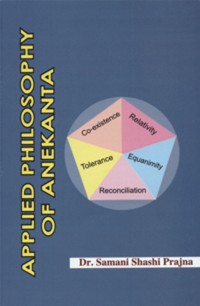After an elaborate analysis of the nature of reality, the question arises what can be the logical criterion of reality? In the Indian system of thought, the following four doctrines are found to have determined as the criterion of reality, viz.
- the doctrine of absolute permanence (kevalanityatā or kūtasthanityatā),
- the doctrine of absolute impermanence (kevala-anityatā),
- the doctrine of absolute permanence and absolute change (nityānityatā)
and - the doctrine of permanence-in-change (pariṇāminityatā).
As the advocate of the doctrine of permanence-in-change, Jain philosophy speaks against the doctrine of absolute permanence and that of absolute impermanence and takes up the middle path of pariṇāmīnityatā (permanence-in-change) in the following manner. Devanandi (9th cent. CE) explains the same view with a slight difference.
tatra paryāyarthikanayāpekṣayā parasparato dravyāccārthāntarabhāvaḥ,
dravyārthika nayāpekṣayā vyatirekṇānupalabdheranarthāntarabhāvaḥ.[1]
It means, from the point of view of modes, these three characteristics (origination) are mutually different from one another and are also different from the substance. From the point of view of substance, these three are not perceived separately. Mere origination does not exist; because that is without stability and departure; like the hair of a tortoise. Likewise, mere destruction does not exist, because it is without stability and origination. Likewise mere stability does not exist, because it is void of destruction and origination. So, an entity must have mutually respective origination, cessation, and permanence.[2]
It was quite natural that in the beginning of the rise of philosophy, every school used to speak in support of its own doctrine and against the invalidity of those of others. But in the age of logic, the Indian scholars advanced the argument that the entity which is capable of performing a function (arthakriyākārin) can be only sat or reality and nothing else. The credit of advancing this logical criterion of arthakriyākāritva, (causal efficiency) goes to the Buddhist tradition. The word 'arthakriyā' occurs in the early Buddhist work Lalitavistara in the sense of being useful to others without any metaphysical significance.
Hemachandra defines the arthakriyākāritva as the criterion of existence or being as the performance of certain specific action, or rather, existence, arthakriyā sāmarthyāt, tallakṣaṇatvād vastunaḥ.[3] It means that a certain effect has been produced in some way (causal efficiency) then it is called Reality.
According to Jain metaphysics, substance and its modes are not absolutely different like substance and its qualities of the Nyāya-Vaiśeṣika Philosophy and they are also not absolutely identical, one merging into the other and thus giving rise to absolute eternalism of the Vedānta or absolute momentarism of the Buddhist system of thought. There exists a relation of identity-cum-difference between them.[4] One mode cannot be different from another because of the continuity of the same substance throughout its existence. This makes the psychical phenomena of recognition and memory possible to occur.[5]
Ācārya Hemacandra advanced the argument that, a Reality as conceived by the Jains, is capable of performing a function. This criterion of Reality can be applied to the concept of substance (dravya) of Jain Philosophy in its defence. According to Ācārya Hemacandra, arthakriyākāritva (causal efficiency) is the criterion of a reality.
 Dr. Samani Shashi Pragya
Dr. Samani Shashi Pragya

